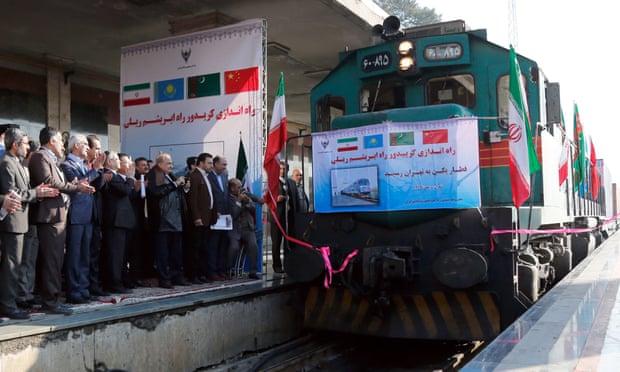Goods travel 6,462 miles in 14 days as part of efforts to resurrect ancient trade route connecting east with Europe

A long-distance cargo train has travelled from China to Iran as part of an attempted revival of the ancient Silk Road, a trans-Asian trade route connecting the east to Europe and the Mediterranean Sea.
The 32-container train, which arrived in Tehran on Monday, took 14 days to complete the 6,462 mile (10,399km) journey from China’s eastern Zhejiang province through Kazakhstan and Turkmenistan – one month less than the sea route from Shanghai to the Iranian port of Bandar Abbas.
Iranian officials have indicated that the ultimate aim is to extend the rail route to Europe, positioning Iran on a key stretch to the continent. The train, which departed from Zhejiang’s trading hub Yiwu, travelled an average of more than 700km a day.
“Countries along the Silk Road are striving to revive the ancient network of trade routes,” said Mohsen Pour Seyed Aghaei, president of the Islamic Republic of Iran Railways company, according to Iran’s semi-official Mehr news agency. “The arrival in Tehran of the train in less than a fortnight has been an unprecedented achievement.”
He said the train had outstripped “truck and road transport” and demonstrated the great advantage of the route.
China is Iran’s biggest trading partner. Commercial ties continued despite decade-long international sanctions over Tehran’s nuclear programme, which were lifted in January after last year’s landmark nuclear deal.
Last month, Chinese president Xi Jinping became the first global leader to visit Tehran since the sanctions were lifted. The two nations signed an agreement on boosting trade to $600bn (£420bn) over the next decade.
The revived Silk Road is envisioned as a rail and sea route, part of China’s “One Belt, One Road” economic development strategy. An Iranian container ship, the Perarin, arrived in Guangxi in southern China last month, delivering 978 containers from a number of countries along the maritime route.
The 32-container train, which arrived in Tehran on Monday, took 14 days to complete the 6,462 mile (10,399km) journey from China’s eastern Zhejiang province through Kazakhstan and Turkmenistan – one month less than the sea route from Shanghai to the Iranian port of Bandar Abbas.
Iranian officials have indicated that the ultimate aim is to extend the rail route to Europe, positioning Iran on a key stretch to the continent. The train, which departed from Zhejiang’s trading hub Yiwu, travelled an average of more than 700km a day.
“Countries along the Silk Road are striving to revive the ancient network of trade routes,” said Mohsen Pour Seyed Aghaei, president of the Islamic Republic of Iran Railways company, according to Iran’s semi-official Mehr news agency. “The arrival in Tehran of the train in less than a fortnight has been an unprecedented achievement.”
He said the train had outstripped “truck and road transport” and demonstrated the great advantage of the route.
China is Iran’s biggest trading partner. Commercial ties continued despite decade-long international sanctions over Tehran’s nuclear programme, which were lifted in January after last year’s landmark nuclear deal.
Last month, Chinese president Xi Jinping became the first global leader to visit Tehran since the sanctions were lifted. The two nations signed an agreement on boosting trade to $600bn (£420bn) over the next decade.
The revived Silk Road is envisioned as a rail and sea route, part of China’s “One Belt, One Road” economic development strategy. An Iranian container ship, the Perarin, arrived in Guangxi in southern China last month, delivering 978 containers from a number of countries along the maritime route.

No comments:
Post a Comment